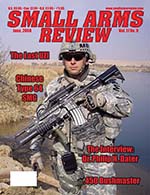American Snipers: America's Long Distance Service Providers
By Jason Wong
The Carlos N. Hathcock II Award is awarded annually by the National Defense Industry Association, Small Arms Division Executive Board. Named in honor of Gunnery Sergeant Carlos N. Hathcock II, the award commemorates the life of a career Marine that dedicated his life to the service of the United States in both the military and law enforcement communities. “The Gunny” distinguished himself in combat as a scout-sniper, and also as a competitive marksman and trainer. Honest, actful, considerate, courageous, quietly proud and determined in all things and all places from the range to the battlefield, GSGT Hathcock significantly impacted the current United States Marine Corps Scout-Sniper Program and influenced sniper programs of the other military services and law enforcement programs nationwide.
In recognition of Carlos Hathcock’s contributions to the military and law enforcement sniper community, the Carlos N. Hathcock II Award is presented in recognition of an individual or organization that has made significant contributions in operational employment and tactics of small arms weapons systems resulting in an impact on the readiness and capabilities of the United States military or law enforcement. The 2007 award was presented to AmericanSnipers.org for their contributions to the U.S. Military sniper community in the on-going Global War on Terror.
In late 2003, a small group of US police snipers formed a support network to address the operational equipment needs of US military snipers deployed abroad in the war on terror.
Formerly known as the Adopt A Sniper program, the effort began as a simple request for assistance among deployed friends in the National Guard and Reserve, who as civilians, also served as police officers. These police officers were employed as SWAT team snipers at home, and were assigned as snipers within the United States military. Once deployed, the citizen-soldier snipers requested assistance from their SWAT sniper friends in procuring specialized gear which was better suited for their missions and could not be supplied by their military units.
As the Global War on Terror progressed, the urban mission profiles of US police snipers and US military snipers were found to overlap. In addition, the gear and supplies needed to accomplish the two seemingly different missions were found to be virtually identical.
Due to the enormity of the commitment in Iraq and Afghanistan and the differences between the various units and staff personnel, many American snipers and designated marksmen were unable to procure the necessary equipment required to complete their missions. Snipers and designated marksmen were spending their own funds and enlisting help from their families and friends in procuring gear. Due to the cost and difficulty of procuring equipment, many servicemen often go without gear desperately needed, due to the expense associated with procuring it.
Currently, the U.S. military utilizes fully fledged sniper teams who are often fully trained and equipped, and designated marksmen of mechanized, mortar or cavalry units who, like their full fledged sniper brethren, are also assigned what is normally a sniper’s job. Unlike the more highly trained sniper, the designated marksman is often a non-infantry soldier within in the position without the training and ancillary gear normally issued to the infantry sniper.
The designated marksman position is often assigned to one or two soldiers within a platoon to provide the support of a sniper at the platoon level. Unfortunately, Stryker-equipped mechanized infantry, and other non-infantry units are often equipped with either an accurized M16 rifle, or an M14 rifle. The M14 rifle issued may be of Vietnam-era vintage, and older than the soldier’s parents. As sniper related gear is frequently not on the Modified Table of Equipment for Stryker and other non-infantry units, these marksmen are asked to complete their mission without equipment normally associated with the sniper mission, and frequently with nothing more than a rifle. Amazingly, as U.S. soldiers have always done, these soldiers are doing the job regardless of the obstacles presented.
AmericanSnipers.org organizational mission is to assist soldiers by providing the equipment and gear needed to accomplish the task. Formed in 2004, AmericanSnipers.org began with a few police officers sending gear from their own gear bags. Using contacts developed throughout the US police and military sniper communities, American Snipers.org networked with military snipers deployed abroad, obtained overseas addresses, and began sending desperately needed gear and supplies that are specifically tailored to the sniper mission. The organization has supported snipers and designated marksmen in over 425 different platoons of the United States military and has raised hundreds of thousands of dollars in funds and gear for US snipers in all branches of the armed forces.
Snipers and designated marksmen are encouraged to work through their own supply systems and to make their needs known to their superiors to maintain continuity and flow of information.
However, that failing, AmericanSnipers.org has the ability to provide gear that goes directly to the military address of the sniper himself. When the sniper’s deployment ends, the sniper is asked to give the equipment to his replacement (if it is serviceable) or keep the equipment if he re-enlists and plans to return to overseas duty in a sniper billet.
The organization has grown into a full time program funded entirely by civic donations, and staffed by 12 police and U.S. military snipers from across the United States. One hundred percent of monetary donations is applied directly towards supporting Soldiers and Marines, whether by purchasing needed equipment, paying shipping charges, or conducting fund raisers for a US military sniper platoon deployed abroad. AmericanSnipers.org operates as 501(c)3 non-profit charity, allowing tax-deductible donations. No volunteer receives a salary in any form and the entire effort is conducted on the staff’s own time.
For more information, visit www.americansnipers.org.
This article first appeared in Small Arms Review V11N9 (June 2008) |
| SUBSCRIBER COMMENT AREA |
Comments have not been generated for this article.





